Platoon locality with buried HQ
Posted: 2 May 2009 08:26
I took an aimless wander along a stretch of the Downs that I'd previously not explored. I wasn't expecting to find anything except some beautiful scenery, so I was surprised to find an intact platoon locality with a buried HQ.
This was totally unexpected and a complete reverse of my usual method of visiting areas mentioned in documents to see what remains; in this instance I was completely blind due to my stumbling on this location by accident. In some ways this is actually more exciting than basing field visits on reading documents first; it's a greater challenge to find evidence in the field and then find documents that describe what was going on. There's a twist to this that I'll come back to later; right now you're more interested in what I found.
The first discovery was a slit trench, and, although I clocked it as a possible earthwork, I dismissed it due to my having no documentary evidence for it at this location. In hindsight, this was a mistake.
Moving further along a footpath, I suddenly came across a crater that contained Anderson shelter iron in the bottom; five pairs of panels bolted together and dug in flush with the ground level.
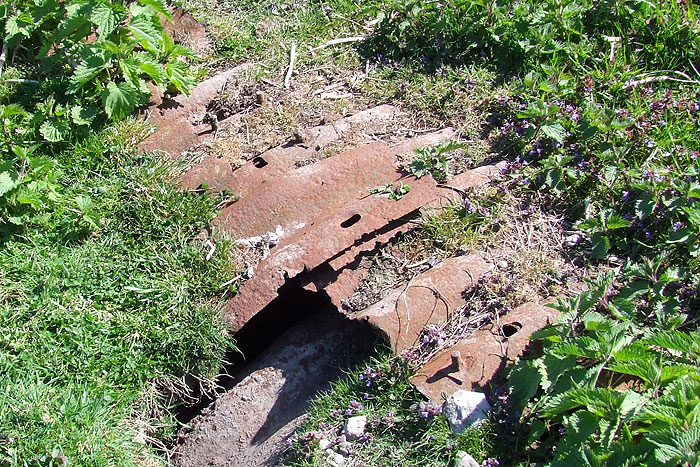
It was this in conjunction with the slit trench that suddenly made me realise that there was a position here.
The HQ has been filled in, as the photo below shows.
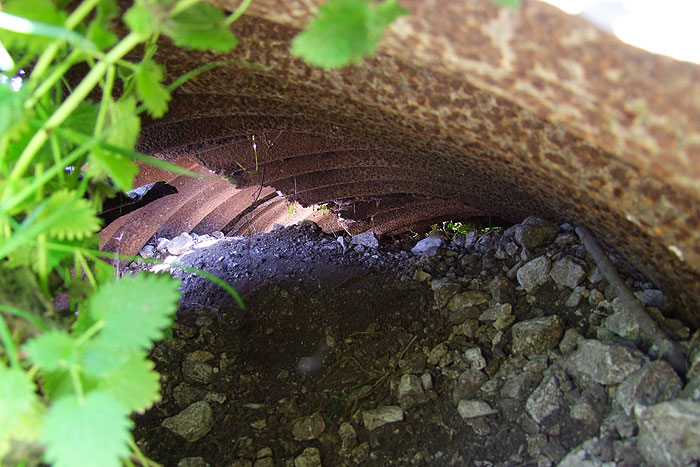
A walk around the area quickly revealed an interesting array of slit trenches:
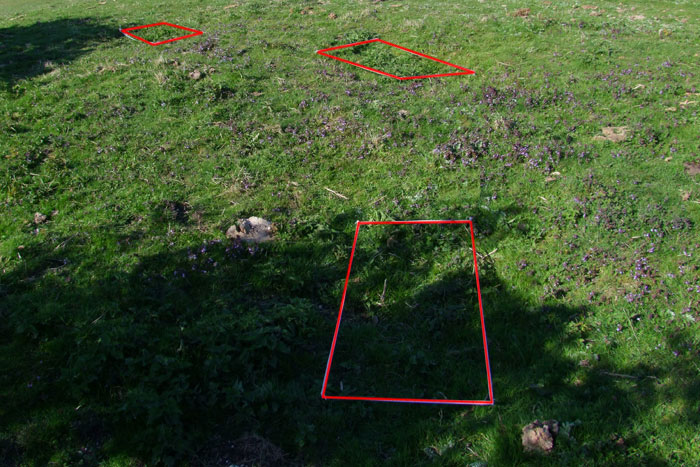
Two or three hours of recording and surveying produced the map below; we have a locality comprising 18 slit trenches, two Vickers guns positions and an artillery observation post (OP).
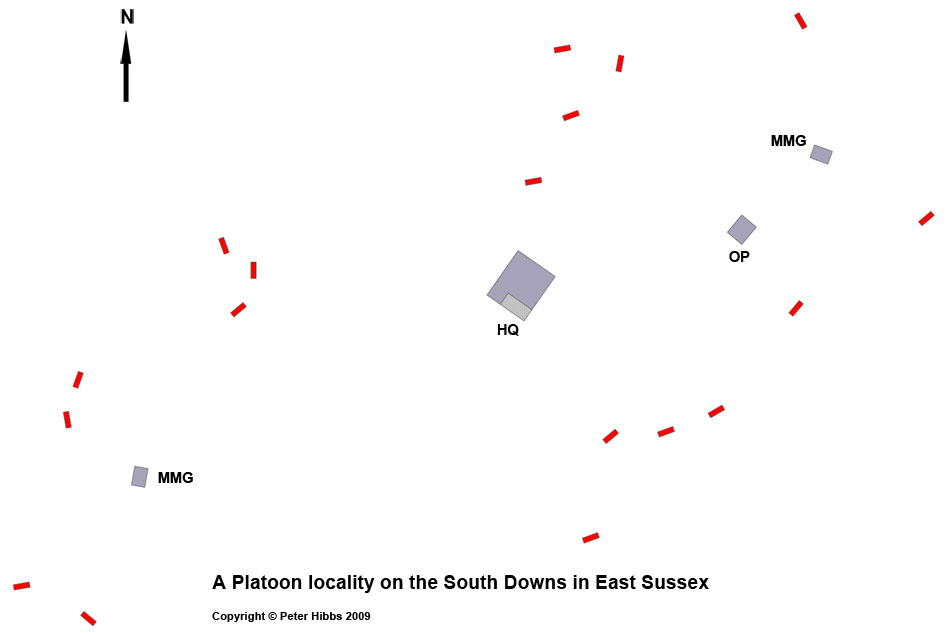
I should now return to the slight twist I mentioned above. There was nothing on my radar because this was an ad-hoc stroll; had I previously checked my database for this area, I would have known that the OP was sited here in late 1940. But this didn't explain the platoon position; I was certain that I had no references to this.
However, after a lengthy search, a couple of paragraphs in a war diary from late 1941 indicate that a change in strategy was being mooted with a company of troops being relocated to hold this area. The diary does not say it actually happened, but the fieldwork suggests that at least some troops (if not an entire company) were dug in up here.
But do we have a platoon locality?
18 slit trenches provide space for 36 men; we also appear to have a section of Vickers MMG (two guns, 12 men). At this point in the war, an infantry platoon comprised 36 men (HQ of 6 men, and three sections of 10 men), so we can assume a garrison of about 48 men. Documents indicate that the OP was no longer in use by the time the infantry dug in, but it wouldn't surprise me if it was used by them assuming it hadn't already been filled in when it was abandoned by the artillery.
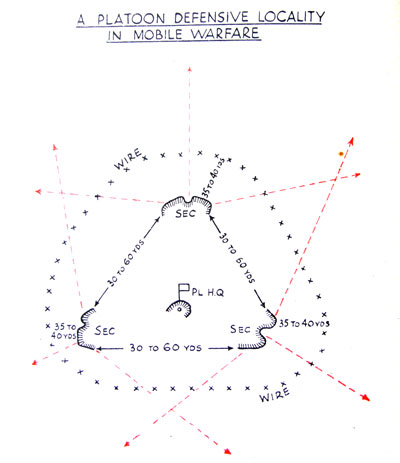
The diagram at right comes from Tactical notes for Platoon Commanders, a 1941 supplement to the 1937 Infantry Training manual.
The latter publication talks of digging slit trenches (or weapon pits/fire trenches which are subtly different) and eventually linking them up with crawl trenches to resemble a WW1 trench system. Even though all-round defence is regarded as necessary, platoon HQ is shown in a diagram as in the rear with a linear system to the front.
As can be seen from the 1941 supplement, lessons had been learned from the opening campaigns of the war; the sections are no longer spread out in line abreast, but now form a triangle around the platoon HQ.
We can actually see the three sections in my plan above; one section of seven trenches and an MMG to the left and if you draw a line HQ-OP-MMG you see the space between the other two. It's not a perfect triangle as the positions have to follow the lie of the land, but we have here a 1942 layout (based on the date of the diary entry).
The Downsforce positions, although constructed in 1941, appear to be based more on the linear system - and, as I write this, a penny has just dropped regarding a possible platoon HQ set to the rear of a line of trenches - I'll need to go and re-examine this area.
We have more trenches than are needed for the infantry sections, but the MMG pits are for two men each, and the rest of the gun teams would have been in slit trenches too. We also don't know how many men were in the HQ, as the platoon's 2-inch mortar team (two men) would probably have been emplaced outside the HQ pit as part of the defence.
Whether I've found all the trenches and am completely correct in my reasoning remains to be seen, but this locality was a fantastic find!
- Pete

Email:
Blog Latest

Bishopstone reveals its pillbox secrets
18 October 2021

Pillbox or Observation Post?
10 June 2020

Uncovering the hidden secrets of a pillbox
8 June 2019

Review of 2018
31 December 2018

Wartime Christmas in East Sussex (2)
24 December 2018
Jargon-buster
Anderson shelter
An air raid shelter for 6-10 persons intended for civilian use. Constructed from panels of heavy-duty corrugated iron, the shelter was to be dug 3 feet into the ground and covered over with spoil. The army also used Andersons as battle headquarters and in the construction of underground posts for Home Guard Auxiliary Units.
Crawl trench
A shallow trench 18 inches deep linking fire positions, allowing men to crawl between them with protection from fire and/or observation.
Platoon locality
A defended locality intended to be held by a platoon.
Slit trench
Small, narrow trench designed to provide protection against shrapnel and other battlefield hazards. Technically distinct from a weapon pit (which was intended soley as a defensive position) slit trenches were also used as defence works.
War diary
A record of events kept by all units from the point of mobilisation. A diary's contents vary enormously from unit to unit; some give detailed entries by the hour on a daily basis while others merely summarise events on a weekly/monthly basis.
This site is copyright © Peter Hibbs 2006 - 2024. All rights reserved.
Hibbs, Peter Platoon locality with buried HQ (2024) Available at: http://www.pillbox.org.uk/blog/216624/ Accessed: 20 April 2024
The information on this website is intended solely to describe the ongoing research activity of The Defence of East Sussex Project; it is not comprehensive or properly presented. It is therefore NOT suitable as a basis for producing derivative works or surveys!